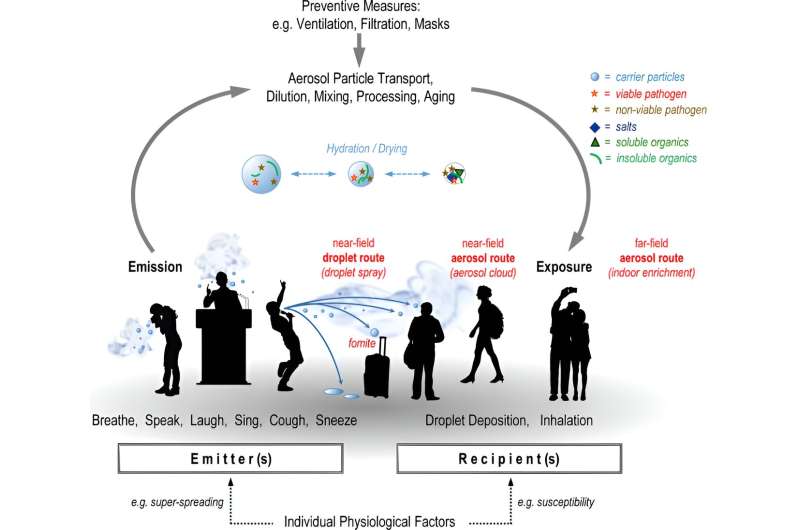by Bob Yirka , Phys.org

A team of atmospheric scientists, chemists and infectious disease specialists at the Max Planck Institute for Chemistry, working with colleagues from the Max Planck Institute for Dynamical Systems, the University of Denver, Georg August University and St. Petersburg State University, has embarked on an effort to collate publicly available information on droplet properties, such as the way they are distributed by size, their composition, and the ways they are emitted, as a means of helping to develop mitigation strategies for fighting infectious agents.
In their paper published in the journal Reviews of Modern Physics, the group describes their collating process and why they believe it could help fight non-contact infectious diseases.
In the early days of the pandemic, as people around the world locked themselves inside their residences, scientists, including those not in the medical field, looked for ways to help. One such pair of researchers, Christopher Pöhlker, an atmospheric scientist, and his wife, Mira, a cloud scientist, began to wonder about the nature of droplet size—something related to both their fields of work.
After getting online and doing some searching, they found little research had been done regarding respiratory droplet size as it relates to airborne disease transmission. That led them to begin a research effort of their own that involved gathering known information and collating it in a way that might prove useful to traditional medical researchers. To that end, they joined up with specialists in other fields to form a team with the goal of parameterizing droplets involved in respiratory infections such as COVID-19.
The team first searched for available information regarding infectious droplet size. They then embarked on a mission to create a parameterization scheme that would collate the data. To that end, they created a classification system based on what they describe as modes, where different modes are based on the size of droplets created in various parts of the body.
They ultimately defined five types in all, each described by its size (from less than 0.2 µm to 130 µm), rather than a name. Each was also classified by the location where it was created: in the lungs, the mouth, tongue or lips and the larynx–trachea. The researchers also left space for data that correlates droplet size with infection potential—specifics that are still not known.
The team concluded by suggesting that human studies will have to be conducted to fully complete their collating process, which they suggest should, when complete, provide medical researchers with a valuable resource as they continue to look for ways to develop anti-transmission measures to combat infectious diseases.
More information: Mira L. Pöhlker et al, Respiratory aerosols and droplets in the transmission of infectious diseases, Reviews of Modern Physics (2023). DOI: 10.1103/RevModPhys.95.045001
Journal information: Reviews of Modern Physics
© 2023 Science X Network

